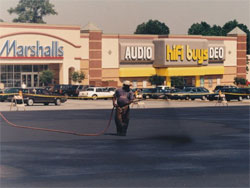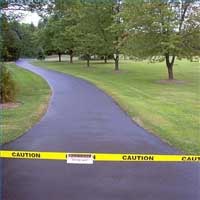Sealcoating Tampa
Sealcoating and Asphalt Repair Tampa
Complete Tampa Sealcoating Services
 A&A Development, Inc. is a proven leader in Sealcoating Asphalt in Tampa. We are very proud of our Asphalt Sealcoating work. Sealcoating Tampa asphalt can be a very expensive. We have the resources and experience to effectively, efficiently and economically provide the services you need. Our professional staff is trained to apply the most advanced coatings and sealants on the market today. Custom Sealcoating is fully insured and we stand behind all of our work.
A&A Development, Inc. is a proven leader in Sealcoating Asphalt in Tampa. We are very proud of our Asphalt Sealcoating work. Sealcoating Tampa asphalt can be a very expensive. We have the resources and experience to effectively, efficiently and economically provide the services you need. Our professional staff is trained to apply the most advanced coatings and sealants on the market today. Custom Sealcoating is fully insured and we stand behind all of our work.
How Sealcoating Works
Research has demonstrated that properly applied (and properly timed) sealcoat can save the owner of a property $100,000 or more — over the life of a hot mix asphalt pavement. But what does seal-coat actually do that results in this substantial savings?
To understand how sealcoating works, it is necessary to understand the nature of the asphalt pavement itself. Because of its excellent waterproofing, flexibility, and adhesive properties to bind and hold the aggregates in the pavement, asphalt has been used extensively for paving and road construction. Prior to the advent of asphalt as a paving material, roads were constructed by spreading graded aggregates over a road bed. These roads worked well as long as the stones remained in place and stayed dry. Naturally, these roads needed constant repair. Stone would shift under the traffic and the road’s load carrying capacity was severely damaged when it rained. The stone would absorb water, swell and lose its strength. But spraying asphalt on the surface overcame this problem somewhat. Asphalt paving technology gradually evolved and today the vast majority of all roads are constructed using asphalt as the binding material for the aggregates. Due to its waterproofing properties, asphalt protects the aggregates from absorbing water, thus preserving their strength and load-carrying capacities. Today’s asphalt pavement is a mixture of stone aggregate and mineral filler combined with 4.5% to 12% (average of 6%) asphaltic binder (asphalt cement). The strength of an asphalt pavement is directly related to the pavement design from the ground up. The asphalt pavement people see is only the “roof,” so to speak, of the entire pavement. This “roof” covers a bed of graded stone aggregates of varying depths according to ground conditions as well as traffic requirements. This base of aggregate is what really carries the load of the traffic. The same theory applies to off-street parking lots or drive-ways. A firm resilient surface that provides a roof over the stone base will keep the pavement bed dry. It is important to have an elastic characteristic in this pavement so that it can expand and contract and still remain intact.
Why seal asphalt?
In spite of its excellent adhesive and waterproofing properties, asphalt has some serious drawbacks that relate to its chemical makeup. Asphalt is a very complex mixture of thousands of chemicals which are predominantly open chain (aliphatic) in structure with a considerable degree of un-saturation within their molecular structure. The open chain provides easy access to weather, salts, and chemicals to attack and disintegrate the asphaltic molecules. As the asphaltic molecules disintegrate, the asphalt in the pavement loses much of its original properties, such as binding and waterproofing. The first visual sign of this phenomenon is a progressive change in the color of asphalt pavement from rich black to brown to gray. Furthermore, asphalt, being a byproduct of the petroleum distillation process, is easily dissolved by other products that also are derived from petroleum, such as oils, fats, grease, mineral spirits etc. The reason is quite logical: As petroleum, these various products existed together for millions of years. It is only through the petroleum refining process that they are separated for various uses. Because these individual products come from the same source, they have a natural affinity for one another and when put in contact with each other will try to join together again. So when automotive oil or gasoline — both petroleum distillates — leak onto an asphalt pavement, they will work to easily dissolve the similar chemicals in asphalt. These problems are associated primarily with off-street pavements such as parking lots, minor streets, airport aprons or runways, service stations, and home driveways, which carry low levels of traffic.
Roads, having the advantage of continuously rolling traffic, do not need protection because the rolling action of the traffic steadily brings the lower layers, rich in asphalt, to the surface and “kneads” the oxidized surface layers back into the pavement. Eventually all the asphalt binder is exhausted and the aggregates begin to unravel due to the absence of the binding cement. This happens to all pavement including roads. The rate of pavement deterioration depends upon the traffic volume as well as climatic conditions. The next step is the development of minor cracks which widen and deepen with time. If the cracks are not repaired at this stage, water seeps into the base courses and damages the pavement’s load bearing capacity. It is evidenced by rutting, shifting, and serious alligatoring. The pavement then must be either overlaid or completely removed and reinstalled, depending on the condition. Off-street pavements do not have the advantage of this “kneading” action. The surface layers of off-road pavements are under continuous attack from the weather and other destructive elements, eventually developing minor surface cracks. Again, aggregates start unraveling producing minor cracks which widen and deepen with time. The damage will continue if proper protective actions are not taken. So it would be logical to conclude that off-street pavements can be preserved by a “protective coating” that resists attack by the elements that destroy the asphalt in the first place.
Two types of sealcoat
 Currently there are two primary types of sealcoating materials on the market: Those made from refined coal tar and those made from asphalt. Refined coal tar —a byproduct of the coking process— is a very complex mixture of thousands of chemicals and quite different in its molecular structure than asphalt. The coal tar molecules have a predominantly closed ring (aromatic) structure with a minor degree of un-saturation. Being stable in molecular structure, these chemicals do not allow the destructive elements of weather and chemicals to affect the property of coal tar. So for a variety of reasons, the most commonly used sealcoatings have, until recently, been based on refined coal tar. These sealcoatings act as “barrier coats” to protect asphalt surfaces. Sealcoatings based on refined coal tar were introduced in the 1950s and have been used extensively to protect off-street pavements. These often are referred to as C.T.P.E. (Coal Tar Pitch Emulsions), denoting that these coatings are water based, obtained by dispersing refined coal tar in a matrix of clay and water. The finished product is a stable, homogeneous composition that is applied with ease and safety in handling. The mineral fillers serve to extend the softening range of the refined coal tar so that the coating will be functional at normal pavement temperatures. The CTPE incorporates the protective features of refined coal tar and the reinforcing effect of mineral fillers, to offer a “barrier coating” that will flex with the pavement’s movements while protecting the asphalt from the destructive elements of weather, gas, oil, fat, chemicals etc. In recent years asphalt emulsion based coatings have been introduced with varying degrees of success. In fact, many sealer manufacturers that previously produced only refined coal tar sealers now also produce asphalt-based sealers or even asphalt/refined coal tar blends. The asphalt emulsions deliver most of the same properties as refined coal tar-based coatings —except for the resistance to color fading due to ultraviolet degradation, salts, and petrochemicals like oils, fats, grease and solvents. These deficiencies are inherent in the asphalt binder itself. Being a petroleum derivative, asphalt has a natural affinity for petrochemicals, so it is easily dissolved by them. Asphalt emulsion-based coatings are made using either a soap emulsion (SS-1-H, for example) or clay stabilized emulsions. Both types are suitable but the properties of clay stabilized emulsions can be controlled better through selection of the right ingredients.
Currently there are two primary types of sealcoating materials on the market: Those made from refined coal tar and those made from asphalt. Refined coal tar —a byproduct of the coking process— is a very complex mixture of thousands of chemicals and quite different in its molecular structure than asphalt. The coal tar molecules have a predominantly closed ring (aromatic) structure with a minor degree of un-saturation. Being stable in molecular structure, these chemicals do not allow the destructive elements of weather and chemicals to affect the property of coal tar. So for a variety of reasons, the most commonly used sealcoatings have, until recently, been based on refined coal tar. These sealcoatings act as “barrier coats” to protect asphalt surfaces. Sealcoatings based on refined coal tar were introduced in the 1950s and have been used extensively to protect off-street pavements. These often are referred to as C.T.P.E. (Coal Tar Pitch Emulsions), denoting that these coatings are water based, obtained by dispersing refined coal tar in a matrix of clay and water. The finished product is a stable, homogeneous composition that is applied with ease and safety in handling. The mineral fillers serve to extend the softening range of the refined coal tar so that the coating will be functional at normal pavement temperatures. The CTPE incorporates the protective features of refined coal tar and the reinforcing effect of mineral fillers, to offer a “barrier coating” that will flex with the pavement’s movements while protecting the asphalt from the destructive elements of weather, gas, oil, fat, chemicals etc. In recent years asphalt emulsion based coatings have been introduced with varying degrees of success. In fact, many sealer manufacturers that previously produced only refined coal tar sealers now also produce asphalt-based sealers or even asphalt/refined coal tar blends. The asphalt emulsions deliver most of the same properties as refined coal tar-based coatings —except for the resistance to color fading due to ultraviolet degradation, salts, and petrochemicals like oils, fats, grease and solvents. These deficiencies are inherent in the asphalt binder itself. Being a petroleum derivative, asphalt has a natural affinity for petrochemicals, so it is easily dissolved by them. Asphalt emulsion-based coatings are made using either a soap emulsion (SS-1-H, for example) or clay stabilized emulsions. Both types are suitable but the properties of clay stabilized emulsions can be controlled better through selection of the right ingredients.
In recent years sealcoat manufacturers have been quite successful refining the performance of asphalt emulsion sealers through the use of specialty chemicals and pigments. But asphalt emulsion’s resistance to petrochemicals and solvents — while improved — has yet to be overcome. In spite of this deficiency, sealcoaters have recognized some definite advantages of asphalt emulsion over refined coal tar sealers: Asphalt emulsion sealcoats are more “user friendly,” practically odorless, and do not irritate and burn the skin (features especially important for people with respiratory conditions or sensitive skin). It is noteworthy, however, that the Federal Aviation Administration Specifications (P-625, 627 and 628) accept only refined coal tar-based sealcoatings for use on airport projects, because the refined coal tar based sealcoatings offer greater resistance to jet fuel.
Mix design on the job
Sealer manufacturers always supply sealer — whether asphalt or refined coal tar — in a concentrated form that has to be diluted 25% to 30% by volume with water and mixed with sand or aggregate for proper textured appearance and non-slip properties. The quantities of water and sand or aggregate are conventionally expressed as a percentage or quantity based on the amount of concentrated sealer. For example, 25%-30% water will denote 25-30 gallons of water added to 100 gallons of concentrated sealer (as supplied by the manufacturer). Similarly, 2-2.5 lbs. of sand per gallon will mean 200-250 lbs. of sand added to 100 gallons of concentrated sealer. The sand must be clean, hard, angular and fall within a specified range of particle size gradation. Too many fine or coarse particles will detract from performance. The relative quantities of binder (asphalt emulsion or refined coal tar), clay, and fillers are crucial to the performance of the sealer. Excessive amounts of clay and fillers in the sealer formulation will produce porous cured films due to insufficient binder, and thus poor performance. Such sealcoat films tend to lack flexibility and wear pre-maturely. Similarly, excessive amounts of sand or aggregate in the mix design degrade the performance in the same manner. Conversely, an excessive amount of binder (asphalt or refined coal tar) might produce tackiness under hot climatic conditions, even after the full cure. Using standard mix designs, both asphalt emulsion sealers and refined coal tar sealers are capable of suspending sand, holding it in wet film, and keeping it bound in the cured film. However, when stretched beyond its capability, the sealer might not suspend the large quantities (more than 5 lbs.) of sand and definitely will not keep large quantities of sand bound in the cured film. Sand and aggregates, like any other filler, have their own binder requirements (the surface of the sand will absorb the binder -refined coal tar or asphalt- from the sealer). Used in excessive amounts, sand will rob enough binder from the sealer film which would have been otherwise available to form a continuous film on the pavement. But for some jobs it is necessary to add larger amounts of sand to fill in the profile of badly weathered pavements and produce a uniform textured appearance. In such instances special mix designs using specialty rubber additives are used that offer satisfactory performance.
Sealcoating can save real dollars for pavement owners. Unsealed pavements will require repairs starting with the second year and could require a one-inch overlay as often as every seven years. Cost savings will be a substantial 65% if the pavement is maintained regularly. Estimated savings for a 10,000-sq.-yd. asphalt pavement are $127,000 over15 years.
